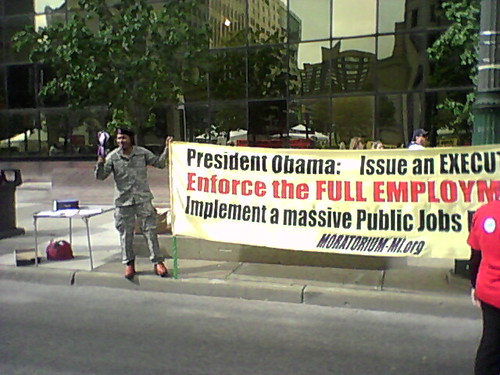
Banner produced by the Moratorium NOW! Coalition for the Labor Day march in Detroit urging President Barack Obama to issue an executive order aimed at enforcing the full employment act. Obama would speak later the same day. (Photo: Abayomi Azikiwe), a photo by Pan-African News Wire File Photos on Flickr.
Weak job gains hurt economic outlook
4:27pm EDT
By Jason Lange
WASHINGTON (Reuters) - American employers hired at the weakest pace in nine months in March, a sign tax hikes that kicked in early this year as part of Washington's austerity drive could be stealing momentum from the economy.
Payrolls expanded by just 88,000 last month outside the farming sector, the Labor Department said on Friday.
That was well below market expectations for a 200,000 increase and fell short of even the most pessimistic forecast in a Reuters poll. The jobless rate ticked a tenth of a point lower to 7.6 percent largely due to people dropping out of the work force.
"The U.S. economy just hit a major speed bump," said Marcus Bullus, trading director at MB Capital in London.
Some of the weakness appeared due to higher tax rates that took effect in January. While recent reports have pointed to relatively buoyant retail sales in January and February, Friday's data showed retailers actually cut staff in March by 24,100, making it the hardest-hit sector last month.
Moreover, the government said hiring in the retail sector was weaker in January and February than initially thought.
The report rattled investors and sent U.S. stocks lower, contributing to the biggest weekly decline for share prices this year. Benchmark Treasury debt yields fell to their lowest this year and the dollar declined against a basket of currencies.
It was unclear whether across-the-board federal budget cuts that began in March played a role in the weak pace of hiring, although nervousness over the cuts might have made businesses shy about taking on more staff.
Some economists cautioned against reading too much into the report, though the data nonetheless raised questions over whether the strong hiring seen in the winter actually meant the economy had shifted into a higher gear.
"We don't think there is enough signal here to conclude the U.S. economy is wobbling. Rather, it appears that the underlying trend has not improved as much as the January-February data suggested," said Julia Coronado, an economist at BNP Paribas in New York.
AMMUNITION FOR THE FED
March's slowdown in job growth could make policymakers at the Federal Reserve more confident about continuing a bond-buying stimulus program. Prior advances in the labor market recovery had fueled discussion at the central bank over whether to dial back the purchases, perhaps as soon as this summer.
"This could give them the green light to stay with this policy longer," said Brian Rehling, chief fixed income strategist at Wells Fargo Advisors in St. Louis.
The employment report did have some positive news for the economy. The Labor Department revised readings for January and February to show 61,000 more jobs added than previously estimated. The average workweek rose to its highest level in a year.
"Companies ramped up working hours instead of hiring additional people. The fact that labor demand kept rising should bode well for future job gains," said Harm Bandholz, chief U.S. economist at UniCredit Research in New York.
The construction sector added 18,000 jobs, reinforcing the view that a recovery in the housing sector has become entrenched.
Separate reports on Friday also gave upbeat signals. The U.S. trade gap narrowed in February due to rising exports and falling crude oil imports, while U.S. consumer credit that month recorded its biggest increase in half a year.
AUSTERITY'S BITE
But analysts point out that federal spending cuts have only just begun and will be a more substantial drag on the economy between April and June, when many government workers begin taking days off work without pay.
In March, government payrolls fell only 7,000, partly reversing a 14,000-job gain from February.
The Congressional Budget Office has estimated that tighter fiscal policy will subtract about 1.5 percentage points from economic growth this year.
"The trend in payrolls is consistent with our expectation that employment growth will slow somewhat in coming months (due to) the large, and increasing, fiscal drag," said Michael Gapen, an economist at Barclays in New York.
Fed Chairman Ben Bernanke, who has said the labor market must show sustained improvement before monetary stimulus is eased, has voiced concern about the spending cuts.
The jobless rate fell to its lowest since December 2008, but the report showed that much of the drop was due to the labor force shrinking by 496,000 people.
That pushed the labor force participation rate - the percentage of working-age Americans either with a job or looking for one - to 63.3 percent, its lowest since 1979.
The unemployment rate is derived from a survey of households which is separate from the survey of employer payrolls. The household survey actually showed employment fell by 206,000 in March.
Some of the people dropping out of the labor force are retiring or going back to school, but others have given up the job hunt out of discouragement.
(Additional reporting by Doug Palmer and Lucia Mutikani in Washington; and by Richard Leong in New York; Editing by Andrea Ricci and David Gregorio)
1 comment:
Thanks so much!! Your site looks nice. Wikidot sounds perfect!
Dubai Data Recovery
Post a Comment